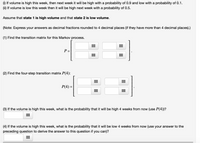
Advanced Engineering Mathematics
10th Edition
ISBN: 9780470458365
Author: Erwin Kreyszig
Publisher: Wiley, John & Sons, Incorporated
expand_more
expand_more
format_list_bulleted
Concept explainers
Question

Transcribed Image Text:(1) If volume is high this week, then next week it will be high with a probability of 0.9 and low with a probability of 0.1.
(ii) If volume is low this week then it will be high next week with a probability of 0.5.
Assume that state 1 is high volume and that state 2 is low volume.
(Note: Express your answers as decimal fractions rounded to 4 decimal places (if they have more than 4 decimal places).)
(1) Find the transition matrix for this Markov process.
P =
(2) Find the four-step transition matrix P(4):
Р(4) %3
...
...
...
(3) If the volume is high this week, what is the probability that it will be high 4 weeks from now (use P(4))?
(4) If the volume is high this week, what is the probability that it will be low 4 weeks from now (use your answer to the
preceding question to derive the answer to this question if you can)?
Expert Solution
This question has been solved!
Explore an expertly crafted, step-by-step solution for a thorough understanding of key concepts.
This is a popular solution
Trending nowThis is a popular solution!
Step by stepSolved in 3 steps with 2 images

Knowledge Booster
Learn more about
Need a deep-dive on the concept behind this application? Look no further. Learn more about this topic, advanced-math and related others by exploring similar questions and additional content below.Similar questions
- Is the answer 0.5 or 0.05076. Please show work If Missy is late for school one particular day of the week, the probability she arrives on time the next day is 0.8. If she arrives on time one day, the probability she arrives late the following day is 0.3. What is the probability she was late on Thursday?arrow_forwardFrank noticed that his mother will serve salad with dinner 78% of the nights, will serve potatoes with dinner 30% of the nights and will serve both 14% of the nights. The probability, to the nearest hundredth, that Frank's mother will serve salad or potatoes isarrow_forwardWhat is the probability you will roll a double (two 1 ’s, two 2 ’s, two 3 ’s, and so on)? Your answer may be short but you must show what numbers you multiplied/divided/added/subtracted by to get your final answer. It would be written in ” P(E) = ” form.arrow_forward
- Please solve the attached problemarrow_forwardThe probability that an applicant will be approved for a mortgage is 0.15. Each applicant has the same probability of being approved and the event that they are approved are independent. What is the probability that out of three applicants, exactly two of them get approved? Enter your answer as a decimal, with three decimal places. For example, if the probability is 15.37%, enter 0.154arrow_forwardHi! I pretty much don't understand this problem that was presented on my Statistics classarrow_forward
- solve the followingarrow_forwardPlease provide steps for how you got the solution to the problem provided below. A machine is used to produce one of each of two types of product (A and B) on alternating days, i.e., if A is produced today then B will be produced tomorrow and vice versa. Each day, there is a probability that the machine malfunctions. Malfunction probability after a day of operation is 0.03 when producing A and 0.07 when producing B. Once the machine malfunctions, it is no longer operable and will not be replaced until sometime in the future (beyond modeling horizon). Model the system as a Markov chain (give transition matrix on your paper). Suppose that on Monday product A was produced. Find the probability that the machine is still operable by the morning of Thursday. Your model should have a state ”malfunction”, which cannot transition to any other state other than itself.arrow_forwardSolve Part B only for question 14 and show work for each step of the problem. Please and thank you.arrow_forward
arrow_back_ios
arrow_forward_ios
Recommended textbooks for you
 Advanced Engineering MathematicsAdvanced MathISBN:9780470458365Author:Erwin KreyszigPublisher:Wiley, John & Sons, Incorporated
Advanced Engineering MathematicsAdvanced MathISBN:9780470458365Author:Erwin KreyszigPublisher:Wiley, John & Sons, Incorporated Numerical Methods for EngineersAdvanced MathISBN:9780073397924Author:Steven C. Chapra Dr., Raymond P. CanalePublisher:McGraw-Hill Education
Numerical Methods for EngineersAdvanced MathISBN:9780073397924Author:Steven C. Chapra Dr., Raymond P. CanalePublisher:McGraw-Hill Education Introductory Mathematics for Engineering Applicat...Advanced MathISBN:9781118141809Author:Nathan KlingbeilPublisher:WILEY
Introductory Mathematics for Engineering Applicat...Advanced MathISBN:9781118141809Author:Nathan KlingbeilPublisher:WILEY Mathematics For Machine TechnologyAdvanced MathISBN:9781337798310Author:Peterson, John.Publisher:Cengage Learning,
Mathematics For Machine TechnologyAdvanced MathISBN:9781337798310Author:Peterson, John.Publisher:Cengage Learning,


Advanced Engineering Mathematics
Advanced Math
ISBN:9780470458365
Author:Erwin Kreyszig
Publisher:Wiley, John & Sons, Incorporated

Numerical Methods for Engineers
Advanced Math
ISBN:9780073397924
Author:Steven C. Chapra Dr., Raymond P. Canale
Publisher:McGraw-Hill Education

Introductory Mathematics for Engineering Applicat...
Advanced Math
ISBN:9781118141809
Author:Nathan Klingbeil
Publisher:WILEY

Mathematics For Machine Technology
Advanced Math
ISBN:9781337798310
Author:Peterson, John.
Publisher:Cengage Learning,

